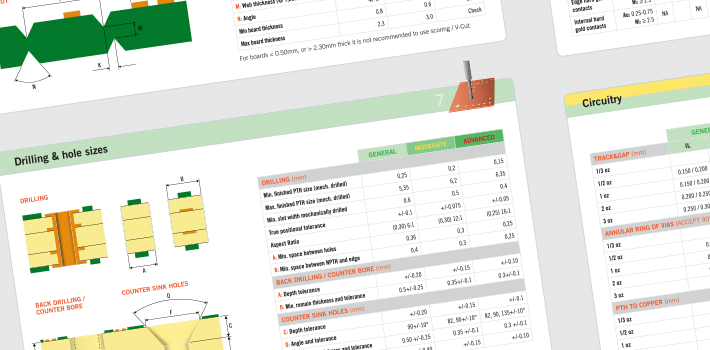It’s all about connections, not simply those that the designers make to define the circuit or the ones that circuit board manufacturers create to fab the PCB. It’s about connecting the design intent with PCB manufacturing capabilities and assembly requirements.

Without these connections, the PCBA will not have the manufacturing robustness or process yield needed to provide the lowest cost of ownership. And let’s face it, no matter how jazzy the design, if it can’t be built across a wide manufacturing base with reasonable yields, and assembled at a number of contract manufactures with similar performance, the total cost is going to be too high and the project is not going to meet profitability targets.
DfM is not a new concept. Design rule checking tools for PCBs have been available for more than 25 years. Simple design rule checks are often the first step in designing profitability into your project. Many of these tools use industry standard guidelines such as those published by the IPC to determine whether or not the schematic design and layout fall within general known manufacturing tolerances. These tolerances can be based on the actual manufacturing practices of the PCB/PCBA supply partner (preferred), the OEM/ODM’s body of knowledge or general guidelines provided in the industries standards.
Designers today are isolated from the printed circuit board manufacturing process and many don’t have access to specific information on manufacturing capabilities or tolerances. They rely on a manufacturing partner, like NCAB Group, to provide them with up-to-date information on manufacturing capabilities. When I talk with a designer who is not familiar with the PCB manufacturing or assembly process, I invite them to come on a tour of one of our facilities and spend a few hours in a PCB basic training course. Feedback from participants has been overwhelmingly positive. Armed with first-hand knowledge about the PCB fab and assembly processes, manufacturing tolerances and industry standards can be more effectively used to form the basis of a well-designed PCB.
A few of the IPC design guidelines are listed below. This is not meant to be an exhaustive list. For more detailed information on the best guidelines for your specific project contact your local NCAB office for recommendations.
- IPC-2221B – Generic Standard on Printed Board Design.
Released in 2013, it replaces the 2221A which was released in 2003. Revisions in the IPC-2221B provide design guidance on via protection, testing and final finish selection, giving designers who have a basic PCB manufacturing understanding more information to make informed decisions about the printed circuit board design and materials of construction. - IPC-2222A – Sectional Design Standard for Rigid Organic Printed Boards.
Released in 2010, it supersedes the IPC-2222 which was originally released in 1998. - IPC-2223B – Sectional Design Standard for Flexible Printed Boards.
The B revision was released in 2008. - IPC-2226 – Sectional Design Standard for High Density Interconnect (HDI) Printed Boards.
Released in 2003, first revision. - IPC-2152 – Standard for Determining Current-carrying Capacity in Printed Boards.
Released in 2009, it replaced the out of date conductor sizing chart that was used in the older versions of the IPC-2221.
There are many DfM tools available today. The goal of these tools is to evaluate the design based on a set of established rules and flag areas in the design where these rules have been violated or where the manufacturing process window has been narrowed to a point where it may impact yields. The basic difference between systems that are used for DfM often comes down to who is using them and where they are going to be applied in the process.
The ideal situation is to bring PCB DfM and that essential design-to-manufacture connection right to the beginning of the design process. This approach provides an early connection between design intent (functionality) and manufacturing capability with an eye to the specific requirements of the assembly and test environments. When using concurrent engineering methodologies, each step of the design process is optimized so that yields are improved across the board. This begins with the placement of components and continues with the routing of critical nets and board layout. Manufacturability criteria can be validated before the layout is finalized using this holistic strategy. When the design is complete all aspects can be reconfirmed across the entire manufacturing platform; checking that PCB fabrication, assembly and test criteria are optimized for optimum performance and maximum yield. If issues are found, they can be resolved quickly and by the part owners before the project is released to manufacturing.
If no concurrent DfM strategies have been used, the PCB manufacturer can employ a pre-production CAM system that will evaluate the design looking for specific design rule violations before the part is released to the manufacturing floor. Design rule checkers highlight violations and provide guidelines for design optimization to improve PCB manufacturing yields. Examples include a flag on a same net spacing violation or a more fundamental issue such as a connectivity error. The down side of this approach is that resolving even simple violations may result in a project delay or even a re-spin of the design.
The need for DfM early in the design process is more important than it has ever been. There are two main factors that drive this need for early involvement; increased PCB complexity and today’s global manufacturing base. High volume production that is going to be manufactured off-shore needs to be designed to meet that objective. As an example, there are regional materials sets that offer cost advantages and have performance characteristics to match domestic brands. Knowing which materials are available from off-shore manufacturers is another advantage of working with a global company such as NCAB Group. We can help to design costs out of products by helping choose the best materials to meet the overall project requirements.
In summary, the earlier in the project that we identify potential manufacturing issues, the shorter the overall development time will be. As a result, development cost will be lower and time-to-market faster. The sooner the designer and the design make that connection to real world manufacturing requirements, the faster the project can be delivered and the lower the overall costs will be. Designing with the production manufacturing location in mind will optimized material sets. And working with PCB experts like NCAB Group early in the design cycle, from concept through prototyping and into production will make every project a winning one.
Learn more about Design for Manufacturing – visit one of our seminars
Read more about our PCB Design Support

PCB design tools
For more advice about PCB design or applications of PCBs, we
have different PCB tools that can be downloaded for free.
